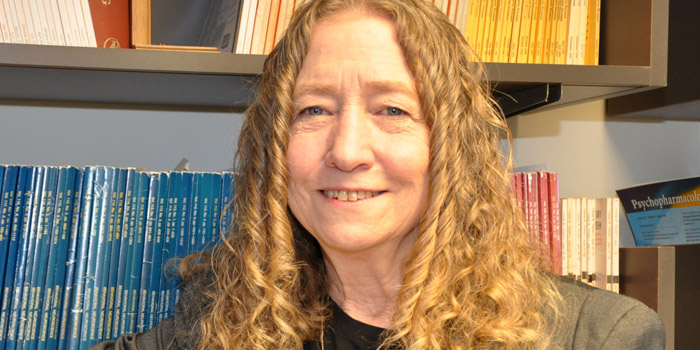Meet the Experts is a series of interviews conducted by experts from the field of Cannabis to world leaders in research and clinical practice of Cannabis as medicine.
Linda A. Parker, Ph.D. is a Tier 1 Canada Research Chair in Behavioural Neuroscience at the University of Guelph, Guelph, Ontario. Her innovative approaches in establishing a rodent model of nausea and implementing a shrew model of vomiting have contributed to discover the critical role of the endocannabinoid system on the regulation of these distressing symptoms.

Her investigations have contributed to our understanding of risks/benefits of cannabinoids, potentially leading to new treatments to chemotherapy-related nausea and vomiting. Dr. Parker is currently president of the Canadian Consortium for Investigation of Cannabinoids (CCIC) and received the Lifetime Achievement award from the International Cannabinoid Research Society (ICRS) in 2016.
She has recently written a scholarly book, "Cannabinoids and the Brain", published in 2017 by MIT press.
Fundación CANNA: Your area of expertise is the molecular mechanism of nausea and vomiting. How did you start doing research on the endocannabinoid system? Did it just happen by chance?
Linda Parker: I was interested in conditioned taste aversion, a kind of Pavlovian learning that rodents display which is the most robust form of learning now known. If rodents become ill following ingestion of a novel flavor, they will avoid consuming that flavor in the future. This learning occurs following a single pairing and even if the illness is delayed by several hours. At the time, the scientific community did not readily accept that such robust learning could occur, because the maximal time interval between two Pavlovian stimuli (taste and illness) for an association to occur was then considered to be a matter of seconds. This work highlighted the importance of understanding the biology of the organism in the investigation of what can be learned which settled the basis for a new branch of psychology: Psychobiology.
Rats and mice are species which have evolved lacking a vomiting reflex, so they need to be extremely cautious when they encounter a food they have never tasted—it may be toxic. Since they cannot vomit, rodents have adapted by displaying neophobia (fear of new) to novel tastes. After tasting a new flavor, once a given amount of time has passed during which they do not get sick, they will return to the food and devour it. In my very first publication, we determined that the time for neophobia to habituate is about 6 hr, and is susceptible to interference from another novel flavor introduced at a delay of 0 min or 45 min, but not 90 min. This is a very simple test of memory that is currently being used by several laboratories to investigate the neurobiology of learning and memory.
I then decided to work with Sam Revusky at Memorial University of Newfoundland, who had developed a fascinating theory for why novel flavors were so readily associated with illness, called the interference theory. Indeed, Sam argued that taste aversion learning is no different than any other kind of learning when one takes biological relevance of the conditioned stimulus (flavor) and the unconditioned stimulus (illness) into account. Consider the rat in the cage in the laboratory that is experiencing all of the sounds, smells and visual stimuli of the laboratory conditions. Then that rat is given a novel taste that it has never experienced before and, sometime later (minutes or hours) the rat is injected with a drug that produces illness, such as lithium chloride (LiCl). According to interference theory, two stimuli can become readily associated if no other biologically relevant stimuli intervene during the inter-stimulus interval.
During my graduate years an important paper was published in Science by Harvey Grill and Ralph Norgren at Rockfeller University, which demonstrated that even though rats do not vomit, they display a unique behavioral response, called gaping (wide open mouth exposing their bottom teeth), when they are orally infused with a taste that has previously been paired with illness. During the 1990's my students and I determined that the conditioned response of gaping is only produced by drugs which produce illness and may serve as a preclinical model of nausea in rats. Rats and mice strangely avoid consuming flavors paired with almost any drug, including drugs that they readily self-administer or that produce a conditioned preference for a place, such as morphine and amphetamine. However, they only display gaping to a flavor paired with a drug that produces a vomiting response in an emetic species, such as a ferret or a shrew. Drugs such as ondansetron, 5-HT3 antagonist and classic anti-emetic drug, prevent the establishment of conditioned gaping produced by the emetic drug LiCl, but do not modify conditioned suppression of consumption. Therefore, gaping behavior is a more specific and selective model of nausea than is consumption of the drug paired taste.
Our first venture into cannabinoid research was the use of the conditioned gaping model to demonstrate experimentally that Δ9-tetrahydrocannabinol (THC) reduces nausea. Raphael Mechoulam read that paper and sent me a snail-mail letter in the year 2000 suggesting that we collaborate to see if cannabidiol (CBD) may also reduce nausea. My entire research program took a turn towards the fascinating world of cannabinoid research. We all know what an amazing, supportive and brilliant collaborator Raphi is to those who work with him. He invited me to participate in the 2002 meeting of the International Cannabinoid Research Society (ICRS) in Asilomar, California and opened the door to a myriad of wonderful collaborations that have shaped my future research directions.
FC: Nausea and vomiting associated to chemotherapy are one of the recognised clinical applications of cannabis. Can you explain in simple words how that works?
LP: We use house musk shrews to investigate the potential of treatments to reduce vomiting and the rat gaping model to investigate the potential of treatments to reduce nausea. Vomiting is quite well controlled by currently available anti-emetic treatments, but nausea is much less well controlled. Therefore, our work has focused more on the use of the rat gaping model of nausea to discover new treatments for this disorder. The rat is a better species for investigating nausea than an emetic species, because they receive the same nausea signals from the gut to the emetic regions of the brainstem, but they just lack the motor output of vomiting. We can therefore, study the signals for nausea in the absence of the confound of vomiting in rats.
Over the years, my students and I have used the gaping model to identify a neurobiological mechanism that may regulate nausea in the interoceptive insular cortex. First, we found that depletion of forebrain serotonin with selective lesions of brain nuclei prevented LiCl-induced conditioned gaping responses in rats. We reasoned that the insular cortex may be the forebrain cortical site of regulation of nausea, because it is the site in which nausea is produced in humans as well as the site of convergence of gustatory and visceral (gut) input. Then we discovered that selective lesions to the insular cortex also prevented LiCl-induced conditioned gaping in rats, an effect that was mimicked by the classic anti-emetic drug, the 5-HT3 antagonist ondansetron, when delivered to the interoceptive insular cortex but not the gustatory insular cortex. Furthermore a 5-HT3 agonist potentiated LiCl-induced conditioned gaping in this same region and produced gaping on its own. Therefore, we discovered that nausea appears to be "turned on" by activation of excitatory post-synaptic 5-HT3 receptors in the interoceptive insular cortex.
Since the receptors for cannabinoids (CB1) are found on the terminal endings of serotonin neurons, we reasoned that it may be at this site that endocannabinoids act to reduce nausea in the interoceptive insular cortex. Indeed, we found that the endocannabinoid, 2-arachidonyl glycerol (2-AG), but not anandamide reduced nausea by acting on CB1 receptors in the interoceptive insular cortex. We are currently using in-vivo microdialysis in the interoceptive insular cortex to test the hypothesis that 2-AG acts on CB1 receptors located on serotonin neurons to reduce the release of serotonin produced by a nauseating treatment.
FC: You have tested almost every cannabinoid, both natural and synthetic, on your preclinical models. Which one do you think holds more promise for its clinical application and why?
LP: One of the most interesting findings in our cannabinoid/nausea work has been identifying the mechanism of action of both CBD and cannabidiolic acid (CBDA) in the regulation of nausea, in collaboration with Roger Pertwee's group. We have shown that the suppression of nausea by both compounds is mediated by their agonism of inhibitory somatodendritic 5-HT1A autoreceptors in the dorsal raphe nucleus. Agonism of these receptors acts to decrease the firing of serotonin neurons projecting to the forebrain and therefore reducing the release of serotonin at terminal regions, possibly including the interoceptive insular cortex. We are currently testing the hypothesis that CBD and CBDA act to reduce nausea by reducing serotonin release in the interoceptive insular cortex using in-vivo microdialaysis. We found that when systemically administered, CBDA is about 1000 times more efficacious than CBD in reducing LiCl-induced nausea using the conditioned gaping model in rats. Indeed, when subthreshold systemic doses of CBDA and ondansetron are combined, there is a dramatic synergistic suppression of nausea measured in the gaping model, possibly because they are both suppressing the impact of nausea inducing serotonin in the interoceptive insular cortex. This is worth following up in clinical trials with humans.
FC: Because of your level of especialization, you have collaborated with almost every single cannabinoid research group in the world. Some of these investigators are fierce competition with each other. How has been this experience?
LP: I have thoroughly enjoyed all of my fabulous collaborations over the years with investigators including, most notably Raphi Mechoulam who brought me into the cannabinoid world, but also Roger Pertwee, who accepted me as a "psychologist" in the harder world of chemistry/pharmacology. Our group has also worked with such notable collaborators as Keith Sharkey, Aron Lichtman, Alex Makriyannis, Daniele Piomelli, Ben Cravatt, Vincenzo DiMarzo, John Salamone, and currently Ruth Ross and Per-Vincenzo Piazza. All of these have been extremely positive experiences and I have never experienced any competition between these groups in my interactions with them.
FC: How is your relationship with industry? You have collaborated several times with GW pharmaceuticals. Now the cannabis industry is blooming in Canada: are you in touch with any of the major Canadian groups?
LP: I have been very fortunate in my interactions with industry over the years. Our work with GW pharmaceuticals funded my post-doctoral student Erin Rock to conduct several studies with novel cannabinoids that resulted in several peer-reviewed publications over the course of the work. Most recently, we have held a collaborative research and development grant funded at matching grants from the National Sciences and Engineering Research Council (NSERC) of Canada and Prairie Plant Systems that maintained Erin Rock's funding and resulted in several publications on the effects of CBDA combined with THC on nausea, anxiety and pain. We have never had any issues with publication of our results in these interactions.
FC: What do you think of the recreational use of cannabis? What is your opinion on the imminent legalization in Canada?
LP: I have somewhat mixed feelings about this. On the one hand, legalization provides an opportunity to regulate cannabis and take it out of the hands of the black market. On the other hand, so little high-quality research has been done with cannabis in humans, given the illegal status of the drug.
FC: One of the current concerns arising from the increased access to cannabis in the US is the "cannabis hyper-emetic syndrome", which is received with a mix of worrisome and skepticism. Can you explain us what is it and how dangerous could it be?
LP: Although low doses of THC reduce nausea, we have recently found that high doses of THC actually produce nausea in the rat gaping model. This biphasic effect is typical of cannabinoids. We also know that both effects are produced by the action of THC on the CB1 receptor. We are currently evaluating the hypothesis that high dose THC may produce down regulation of CB1 receptors and possibly upregulation of the enzymes that degrade endocannabinoids.
FC: Patients often contact basic researchers directly, looking desperately for answers to their clinical situation. Has this happened to you? How do you cope with it?
LP: I try to tell them what is known, to the extent that I can advise. I also suggest that it may be best to talk with someone who works directly with patients rather than rats, like me.
FC: You recently authored a book published by the MIT press: "Cannabinoids and the Brain". Where did the idea came from? What would you like readers to learn with it?
LP: It was the impending legalization of cannabis in Canada that made me decide to write this book so that I could get a better handle on what we know and what we don't know about the effects of cannabis. The book begins with an introduction to cannabis and the endocannabinoid system and then reviews our state of knowledge about effects of cannabinoids on emotional regulation, psychosis, learning and memory, reward/addiction, feeding, nausea, pain, epilepsy and neurodegenerative disorders. So much more work needs to be done, especially high quality double-blind placebo controlled longitudinal studies with humans.
FC: Which of your scientific accomplishment make you feel more proud?
LP: I suppose the opportunities that my students and I have had to interact with some of the very top researchers in the world have been the most satisfying aspects of my scientific career. In terms of the scientific accomplishments of me and my students, I am hoping the best is yet to come. Our mastery of in-vivo microdialysis techniques to directly evaluate the hypothesis that nausea is triggered by the release and action of serotonin on 5-HT3 receptors in the interoceptive cortex, and subsequently turned off by the action of 2-AG on CB1 receptors in this region will finally confirm the story that has evolved over the past 15 years of work in our laboratory.
FC: Thanks so much for your time and for sharing this fascinating story with us, Linda!


